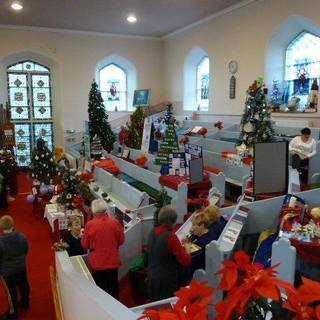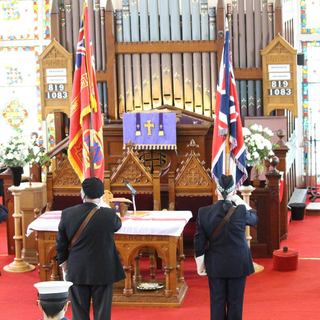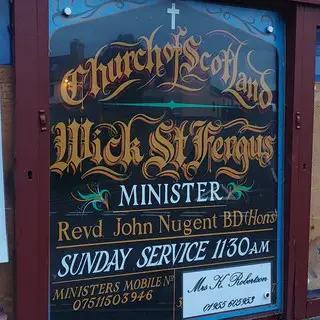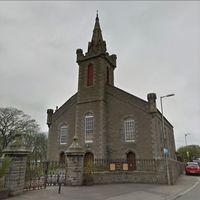We found 4 more Church of Scotland churches near Wick
- Church of Scotland churches in Wick, Highland
- Church of Scotland churches in Highland
- Church of Scotland churches in United Kingdom
- Church of Scotland churches near me
- All churches in Wick, Highland
Who we are
Our Mission Statement
We are a Christian Community with a desire to serve the wide ranging needs of our community and to improve our standards of stewardship of our local environment.
We are a Christian Community with a desire to serve the wide ranging needs of our community and to improve our standards of stewardship of our local environment.
Street Address
Church Pastor
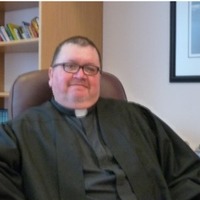
Rev John Nugent
Minister
St Fergus Road
Wick,
Highland
KW1 4NL
United Kingdom
Phone: 01955 602 167 / 07511503946
Download Minister Rev John Nugent vCard with bio
Click here to contact Rev John Nugent
Denomination
Church of Scotland

Affiliations
Church Website
Wick St Fergus Church on Social Media
Leadership
Leader Name:
Rev John Nugent
Leader Position:
Minister
Formal Title:
Leader Address:
Phone:
Fax:
Leader Email:
Click here to contact Rev John Nugent
Leader Bio:
John Nugent B.D. Hons. came to Wick as a locum for two weeks in January 2009 shortly before the union of Wick Bridge Street Church and Wick Old Parish Church on 3rd April 2009 to form Wick St Fergus Church. He stayed on.
Prior to the call to this charge he worked in the Ministry of God's Word in Germany, Orkney, at Camas Outdoor Centre, Ross of Mull. He is an associate member of the Iona Community.
John is a keen musician and his guitar and other string instruments, and Christian songs from parts of Africa are often featured in the services he leads at Wick St Fergus Church
Prior to the call to this charge he worked in the Ministry of God's Word in Germany, Orkney, at Camas Outdoor Centre, Ross of Mull. He is an associate member of the Iona Community.
John is a keen musician and his guitar and other string instruments, and Christian songs from parts of Africa are often featured in the services he leads at Wick St Fergus Church
Rev John Nugent on Social Media:
Other Church Leaders:
Leadership Photos
Administration
Admin Name:
Admin Position:
Admin Address:
Phone:
Fax:
Admin Email:
Click here to contact the church
Mailing Address
Driving Directions
Travel/Direction Tips
Our church is immediately adjacent to the A99 (on the left hand side heading north) which is the main road leading through Wick, Caithness.
Set SAT NAV - KW1 4NL
Set SAT NAV - KW1 4NL
Parking
Ample parking is available on adjacent streets. Attendees and visitors are asked not to park directly in front of the church gates to enable emergency vehicle access should this be needed.
Wick St Fergus Church Service Times
Sunday Mornings at 11.30am
Our Sunday Services
These commence on Sunday morning at 11.30 am and last for approximately one hour. They comprise prayer, hymn singing, bible readings and a sermon. Our choir lead the singing.
The services normally take place in our sanctuary which is on the first floor above ground level. We have two lifts to aid people with mobility issues, walking, wheelchair, or mobility scooter users accessing the sanctuary.
On the last Sunday of each calendar month at 2pm we hold Cafe Church.
This is an informal, family friendly, different way of doing church. All are welcome to join us, grab a seat, have a cuppa, and participate in a discussion group.
It's been more than 10 months since the last service times update. Please make sure to contact the church to confirm service times.
Please contact the church to confirm Service Times or SUBSCRIBE to updates below
Our Sunday Services
These commence on Sunday morning at 11.30 am and last for approximately one hour. They comprise prayer, hymn singing, bible readings and a sermon. Our choir lead the singing.
The services normally take place in our sanctuary which is on the first floor above ground level. We have two lifts to aid people with mobility issues, walking, wheelchair, or mobility scooter users accessing the sanctuary.
On the last Sunday of each calendar month at 2pm we hold Cafe Church.
This is an informal, family friendly, different way of doing church. All are welcome to join us, grab a seat, have a cuppa, and participate in a discussion group.
It's been more than 10 months since the last service times update. Please make sure to contact the church to confirm service times.
Please contact the church to confirm Service Times or SUBSCRIBE to updates below
Worship Languages
Dress Code
Sunday School / Children and Youth Activities
Under 12s:
Sunday School
The children of Wick St Fergus church begin their family worship with the congregation. During the service they continue to worship downstairs at Sunday School or are looked after at creche.
Sunday School takes the form of one main class with children ranging from 4 to 10. The children enjoy their religious and moral teachings presented to them through prayer, song, stories and arts and crafts. The religious teachings follow closely to the church's own calendar with the children taking part during Harvest, Christmas and Easter services.
Our child protection policy is strictly adhered to and there are always two adults present at every session. The children are taught in a secure area within the church.
Our children have a unique ability to enhance our Sunday worship.
The door of Wick St Fergus is always open and we would welcome children to join us.
For further information contact A Duffy, Youth Ministry Team,
Telephone 01955 625732
The children of Wick St Fergus church begin their family worship with the congregation. During the service they continue to worship downstairs at Sunday School or are looked after at creche.
Sunday School takes the form of one main class with children ranging from 4 to 10. The children enjoy their religious and moral teachings presented to them through prayer, song, stories and arts and crafts. The religious teachings follow closely to the church's own calendar with the children taking part during Harvest, Christmas and Easter services.
Our child protection policy is strictly adhered to and there are always two adults present at every session. The children are taught in a secure area within the church.
Our children have a unique ability to enhance our Sunday worship.
The door of Wick St Fergus is always open and we would welcome children to join us.
For further information contact A Duffy, Youth Ministry Team,
Telephone 01955 625732
Under 18s:
Local outreach & community activities
Other activities & ministries
Special Needs/Accessibility
Entry via the main entrance and northmost side door are fully accessible for all including wheelchair users. There are two lifts serving different levels of the Sanctuary.
On the ground floor, accessed from the main entrance, there is a vestry/office/meeting space and a disabled toilet. On the lower ground floor, accessed by stairs from the main entrance or by a level path via the northmost side door, there are male and female toilets, halls and a kitchen.
On the ground floor, accessed from the main entrance, there is a vestry/office/meeting space and a disabled toilet. On the lower ground floor, accessed by stairs from the main entrance or by a level path via the northmost side door, there are male and female toilets, halls and a kitchen.
Prayers and Hymns
Main Bible:
Hymns and Songs:
Other information
Average Adult Congregation:
Average Youth Congregation:
Additional Info:
St Fergus Church Wick Photos
Wick St Fergus Church History
There have been three church buildings on the present site, the first it is thought, was the original Kirk of St Fergus, A remnant only remains of the original church on the present site, a small chapel or transept, known on the survey maps as Saint Fergus Chapel but known locally as The Sinclair Aisle. The oldest memorial in the Sinclair vault is dated 1576 and the oldest burial stone in the surrounding graveyard appears to be 1639 so it might be that the old graveyard at the east end of the town was still used for some time after the church was moved. The first recorded minister was Andrew Philip 1567 - 1576 who then translated to Thurso.
Back in 1613 the incumbent in Bower, Dr. Richard Merchiston also described as Archdeacon, a noted iconoclast, took to visiting the Parishes in Caithness and seeking out graven images on which to vent his wrath. He visited Wick in that year and came upon the image of St Fergus in the old Kirk which he duly attacked and defaced. The townspeople were incensed at the treatment meted out to their saint and would have dealt with Merchiston quite severely on the spot but the magistrates intervened and gave him safe passage out of the town. However the people were not to be denied and a party of them ambushed Merchiston as he rode out along Wick River, dragged him into the water and drowned him. At the subsequent enquiry, witnesses swore on oath that they had seen St Fergus astride the unfortunate minister holding him down in the river.
In 1726 we have a short description of the church written by the minister Mr. Oliphant. In it he states, “The church stands at the west end of the town of Wick, the head burgh of the shire. It is called St Fergus Church and there is at the east end of it on the north side under a little pend, a hewn stone with a man at full length on it which is said to be his effigy engraven on stone. The steeple on the west end seems to be a very ancient work; but there are neither letters nor figures to know its antiquity. On the north side of the church stands the Sinclair’s Aisle, the ancient burial place of the Earls of Caithness where many of them lie interred in a vault. To the east of that on the same side of the church stands the Dunbar’s aisle, the burial places of the family of Hempriggs and in it a handsome monument in hewn stone.”
He goes on to tell us that in 1701 the Parish Church fabric was in a bad state of repair and workmen were employed for “minding ye roof and glassing ye windows.” It seems that the Kirk of that time was a quite wretched place with a thatched roof and seats or chairs that were brought by the people. On August5th 1704 the heritor’s met to get an opinion as to the state of the roof and after deliberation Donald Sutherland, “sclater of Papingoe” was employed to re thatch the roof, the heritor’s agreed, (actually condescended is the word used) to meet the cost of repairs. More repairs were carried out in 1728 and 1752.
Then, in 1765 our church welcomed Rev William Sutherland who was a graduate of Kings College Aberdeen. In his time in Wick Mr. Sutherland made a huge contribution towards Sir John Sinclair’s great work, The Statistical Account of Caithness 1794. Mr. Sutherland wrote the section dealing with the Parish of Wick and it is truly a great study with wonderful insights to the way it was in the social and commercial life of our community. He speaks of the three men credited with beginning the herring fishing, Messrs Miller, Anderson and Sutherland and how 363 barrels were cured in 1782 rising to 10,000 in 1790 before Pulteneytown was even planned. He spoke in detail of local government, agriculture, shops, businesses and trades, the building of the new village of Louisburgh and of course comments on the ways of the people; all in all a quite remarkable social commentary. On the other hand he had some very great trials, not least his difficulties with heritors and magistrates, some of this he brought upon his own head by praying in public for the magistrates of Wick “such as they are.” He had already stated that the old Kirk was falling to pieces and described it as “very old a long, dark ill constructed building, perhaps the worst in Caithness; a new fabric will be soon necessary” and as if to reinforce this, one Sabbath morning the steeple of the ancient church gave way and crashed into the Kirk yard. The Caithness Presbytery decided that this new church would be built at a cost of £1250. 15. 11d sterling and the heritors were duly assessed, with Sir Benjamin Dunbar to provide the bulk of the cash. Shortly after this Sir Benjamin departed the county on military service as did several of his heritor colleagues who were involved in Fencibles duty, Sir Benjamin also resigned his role of undertaker of the project.
This left Mr. Sutherland in a quandary and finally he applied to Presbytery to be allowed to take over the job himself. He had no experience or knowledge of building work but amazingly Presbytery agreed and Robert Corner and Captain Harry Bain both local merchants and burgesses stood as cautioners to the tune of £250 to have the church completed by 1798. Sutherland rejected architects plans nearly all advice and proceeded to have the Kirk built as he saw fit. There were little or no foundations and from the start the building was doomed. As the poorly prepared foundations were being excavated a discovery was made of “people slain in battle and which had been buried without the usual attention.” The remains could possibly been from the battle of Altnimarlach fought up river in 1680; there is no further reference of this or where they were re buried.
The work was completed in June 1799 and there then followed a bitter and protracted wrangle over the inspection of the property, and the heritors led by Sir Benjamin, now returned from duty, eventually carried the case to the Court of Session in 1808. A resolution was never reached and Mr. Sutherland died on June 23rd 1816, that same year Presbytery had the church condemned, Beaton in his writing in 1906 stated that in spite of the sub structural weakness the building never collapsed and it stood for a long time after the present building was in use.
The present church building, the third on this site opened for worship in June 1830 and some difficulties were encountered in the course of its construction In 1822 when the walls were hardly above ground, building operations ceased. The contractor found the operation too much for him. Digging for the foundations of the western gable he had come upon running sand and in order to avoid the mistakes of the previous church he had to bore through to a depth of 30 feet to find a sure foundation. This proved to be his undoing and he failed. For several years the walls stood just above ground until a contractor from Watten, Mr Davidson undertook the work bringing it to a successful conclusion. Most of the stone used to build the church came from the quarries at the north head of Wick and Louisburgh and the woodwork was carried out by Mr. Donald Dunbar of Wick. The roof timbers are huge, 66’ in length 10” wide and 15” deep in red pine brought from Scandinavia by Captain Munro in his ship “Bittern” Wick river was very much wider in those far off days and the timbers were floated up river to the side of the Kirkyard and then manoeuvred to the wall heads, giving the church the reputation of having the widest unsupported roof of any church in Scotland.
The building is 27 metres (90’) long, 22m (72’) wide, 10.5m (33½’) to ceiling, 13m (60’) to the ridge; the spire is 36m (120’) tall. Small spires were to have been built on the four corners of the spire tower and on the two front corners but this idea was dropped for fear that the weight would cause the foundations to sink.
The previous church built 1791 - 1799 was condemned by Caithness presbytery in 1815 because of subsidence. The Rev. Charles Thomson who was admitted to this charge on the 17th September 1840 was of the Evangelical Party of the church and arrived in turbulent times in the national church, which ended in the Disruption of 1843. In its simplest form, the Heritors of the Kirk, the landed gentry, had the say on who should or should not be the minister and could actually pick a minister without reference to the people, and install him into the charge. The people regarded this as intrusion, and rebelled, saying, no more, we will choose our own ministers, we want out of the established Kirk we want a Free Kirk. The culmination of this was a huge meeting or Convocation in Edinburgh in November of 1842, where all in favour of “going out” would sign the resolution, they would then return to their Kirks and lead their people out. In the case of Wick it was a wee bit different. The Rev Thomas Brown D.D. in his book, Annals of the Disruption, which was published in 1890, writes;
“There were cases indeed, in which the people went beyond their ministers in their zeal for the cause. Mr Thomson of Wick, belonged to the evangelical party of the church, but, as the crisis approached, he felt considerable perplexity, and, on returning from the Convocation, he gathered his people together on the 28th November in order to explain, which he did at some length, the reasons why he had NOT seen it his duty to sign the resolutions. (To leave the established Church) During his address the congregation sat looking at each other, much astonished, and after the meeting had been dismissed, the people, on the motion of Mr Davidson, Banker, sat still, elected a chairman, and asked Mr Thompson to listen to the proceedings. They went on to express their views, with much personal respect to their pastor, but in direct opposition to the sentiments of his address. It was then proposed that solemn thanks should be offered up to God, for the grace which had been vouchsafed to the 350 members of the convocation who had bound themselves to “go out” and this was done in a most impressive manner by Mr Donald George. At a second meeting held shortly after, they formally adopted the Convocation resolutions, and the result was that Mr Thomson saw it to be his duty to go along with his people, a resolution that was received with much satisfaction,” So it was, that in the case of Wick Parish Church, it was the people, who led the minister out.”
The story is told that at the first meeting after the exit Mr. Thompson said to his church officer “well I’m glad to see that you have come out with us,” to which the beadle replied “’deed aye sir an’ if ye go back, I’ll go wi’ ye!”
Rev William Lillie was inducted to this charge on 14th February 1844, a very short vacancy indeed. He came to us from Ellon where he was a licensed preacher, teacher of the parish school and actuary for the Ellon Bank which in his time was the bank with the highest deposits of any rural bank. While there he married a Miss Milne, daughter of a prominent local family. When Wick became vacant there was a large list of applicants but Mr. Lillie was chosen and approved by the patron Sir George Dunbar. The call was signed by only 80 people showing how far the disruption had eroded the congregation. Mr. Lillie immersed himself in the affairs of the town gradually winning people back to the Kirk. He had brought his own precentor with him to Wick, a Mr. Shepherd who worked as courthouse keeper but was a weaver to trade. The pulpit of the Kirk in those days was a large octagonal affair reached by a set of steep steps, immediately in front of this sat Mr. Shepherd, with the choir in front of him in a square box or Lateran. This gentleman was responsible for introducing the first trained choir into our Kirk. The building itself was unheated, the pews were all straight backed and the light was provided by the windows and oil lamps. During the early years of his ministry he had many fiery debates with his predecessor but as the years went on they became friendly and often working together. In April of 1875 Mr. Lillie was over on the west side of the county in his capacity of school examiner and he received a severe soaking and he caught pneumonia, later that year he felt well enough to move to his daughters house in Lybster with the intention of going on to Strathpeffer to convalesce but it was not to be and he passed away on Friday 1st October 1875 and now he and Mr. Thompson lie side by side in the Kirkyard.
During 1992 it was decided that as both the church building and church hall (in High Street, now Wick Pipe Band Hall) needed large amounts of money to be spent on them to bring them up to Local Authority Planning Dept. standards, a drastic plan of action was called for. After months of debate and planning, the work to turn the building into a 7 day church under one roof began in November 1993. The Sanctuary was effectively “raised” to the level of the upstairs balcony and the previously rarely used balcony area now forms the heart of the Church Building. The ground floor was extensively refurbished and houses large and small halls, church lounge, kitchen, and toilet facilities. The needs of the disabled are also catered for with a disabled toilet on the ground floor and a stairway wheelchair lift up to the sanctuary.
The organ is a mellow two manual instrument built by Edward Wadsworth & Bro. of Manchester and installed in the Kirk by their representative Mr John Wardle of Aberdeen in 1883 and was the first organ on the Scottish mainland north of Inverness.
Back in 1613 the incumbent in Bower, Dr. Richard Merchiston also described as Archdeacon, a noted iconoclast, took to visiting the Parishes in Caithness and seeking out graven images on which to vent his wrath. He visited Wick in that year and came upon the image of St Fergus in the old Kirk which he duly attacked and defaced. The townspeople were incensed at the treatment meted out to their saint and would have dealt with Merchiston quite severely on the spot but the magistrates intervened and gave him safe passage out of the town. However the people were not to be denied and a party of them ambushed Merchiston as he rode out along Wick River, dragged him into the water and drowned him. At the subsequent enquiry, witnesses swore on oath that they had seen St Fergus astride the unfortunate minister holding him down in the river.
He goes on to tell us that in 1701 the Parish Church fabric was in a bad state of repair and workmen were employed for “minding ye roof and glassing ye windows.” It seems that the Kirk of that time was a quite wretched place with a thatched roof and seats or chairs that were brought by the people. On August5th 1704 the heritor’s met to get an opinion as to the state of the roof and after deliberation Donald Sutherland, “sclater of Papingoe” was employed to re thatch the roof, the heritor’s agreed, (actually condescended is the word used) to meet the cost of repairs. More repairs were carried out in 1728 and 1752.
The previous church built 1791 - 1799 was condemned by Caithness presbytery in 1815 because of subsidence. The Rev. Charles Thomson who was admitted to this charge on the 17th September 1840 was of the Evangelical Party of the church and arrived in turbulent times in the national church, which ended in the Disruption of 1843. In its simplest form, the Heritors of the Kirk, the landed gentry, had the say on who should or should not be the minister and could actually pick a minister without reference to the people, and install him into the charge. The people regarded this as intrusion, and rebelled, saying, no more, we will choose our own ministers, we want out of the established Kirk we want a Free Kirk. The culmination of this was a huge meeting or Convocation in Edinburgh in November of 1842, where all in favour of “going out” would sign the resolution, they would then return to their Kirks and lead their people out. In the case of Wick it was a wee bit different. The Rev Thomas Brown D.D. in his book, Annals of the Disruption, which was published in 1890, writes;
Rev William Lillie was inducted to this charge on 14th February 1844, a very short vacancy indeed. He came to us from Ellon where he was a licensed preacher, teacher of the parish school and actuary for the Ellon Bank which in his time was the bank with the highest deposits of any rural bank. While there he married a Miss Milne, daughter of a prominent local family. When Wick became vacant there was a large list of applicants but Mr. Lillie was chosen and approved by the patron Sir George Dunbar. The call was signed by only 80 people showing how far the disruption had eroded the congregation. Mr. Lillie immersed himself in the affairs of the town gradually winning people back to the Kirk. He had brought his own precentor with him to Wick, a Mr. Shepherd who worked as courthouse keeper but was a weaver to trade. The pulpit of the Kirk in those days was a large octagonal affair reached by a set of steep steps, immediately in front of this sat Mr. Shepherd, with the choir in front of him in a square box or Lateran. This gentleman was responsible for introducing the first trained choir into our Kirk. The building itself was unheated, the pews were all straight backed and the light was provided by the windows and oil lamps. During the early years of his ministry he had many fiery debates with his predecessor but as the years went on they became friendly and often working together. In April of 1875 Mr. Lillie was over on the west side of the county in his capacity of school examiner and he received a severe soaking and he caught pneumonia, later that year he felt well enough to move to his daughters house in Lybster with the intention of going on to Strathpeffer to convalesce but it was not to be and he passed away on Friday 1st October 1875 and now he and Mr. Thompson lie side by side in the Kirkyard.
The organ is a mellow two manual instrument built by Edward Wadsworth & Bro. of Manchester and installed in the Kirk by their representative Mr John Wardle of Aberdeen in 1883 and was the first organ on the Scottish mainland north of Inverness.
Wick St Fergus Church Historical Photos
Add a historical photo
 Help me to avoid every sin
Help me to avoid every sin
Thanks to Thee, O God, that I have risen today, To the rising of this life itself; may it be to Thine own glory, O God of every gift, and to the glory, aid Thou my soul. With the aiding of Thine own mercy, even as I clothe my body with wool, cover Thou my soul with the shadow of Thy wing. Help me to avoid every sin, and the source of every sin to forsake, and as the mist scatters on the crest of the hills, may each ill haze clear from my soul, O God.
Wick St Fergus Church listing was last updated on the 27th of December, 2023


